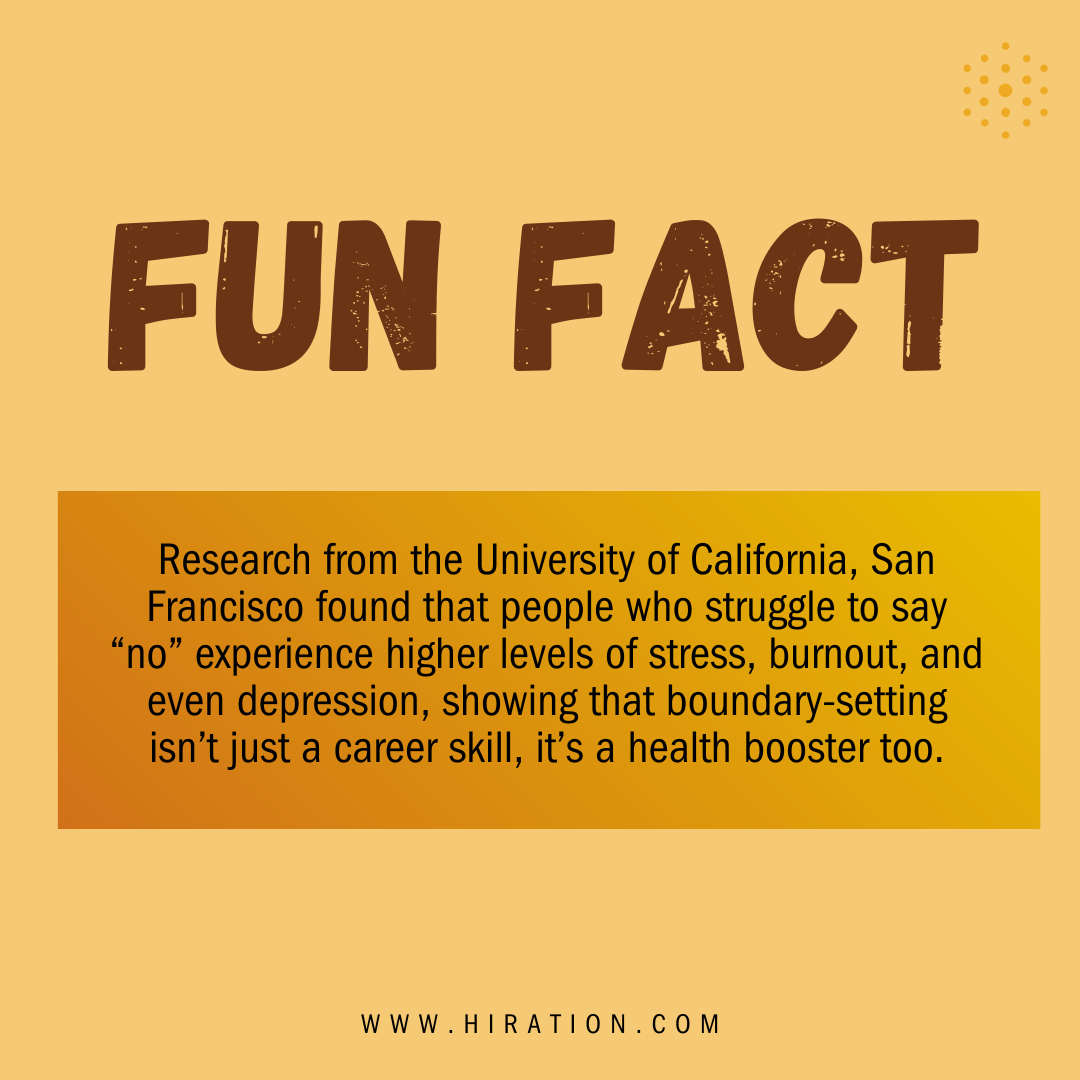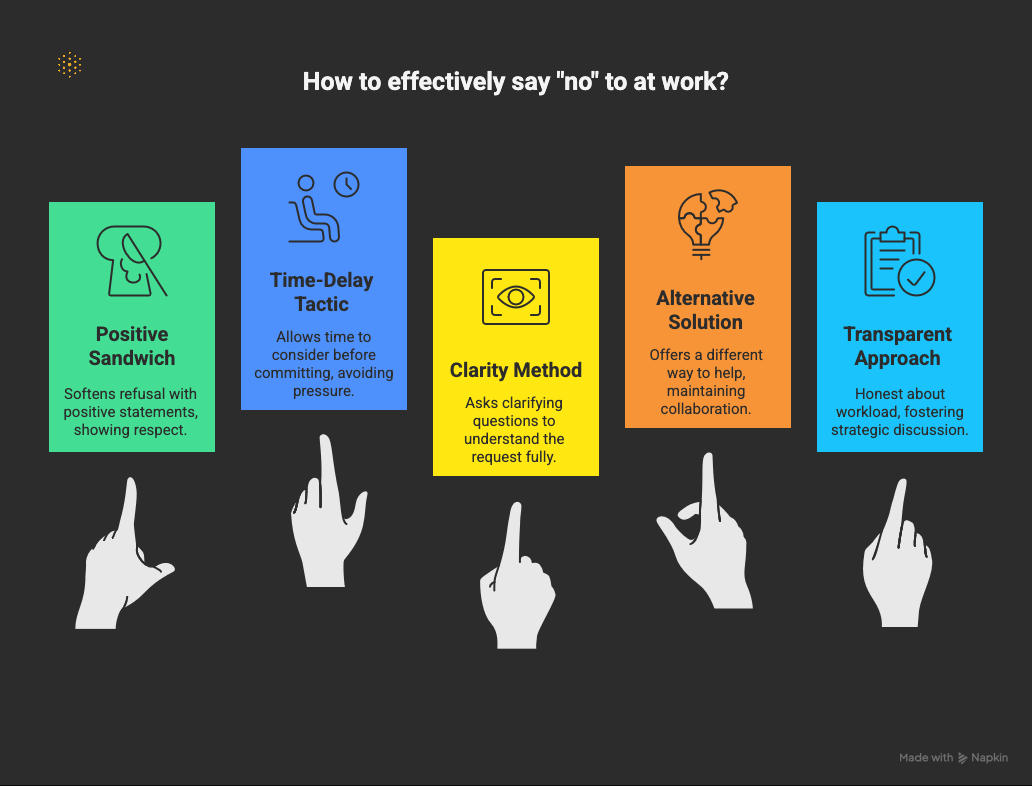How can professionals say no at work without hurting team spirit?
Use strategies like the positive sandwich, time-delay, and clarity methods to decline requests respectfully—balancing boundaries, transparency, and teamwork while protecting focus and preventing burnout.
We’ve all felt it - that moment when a “quick favor” from a colleague or a surprise assignment from your boss lands on your already full plate.
The reflex is almost automatic: you say “yes.” After all, isn’t that what committed, hardworking professionals do?
The problem is, saying yes too often doesn’t prove dedication, it drains it.
Constantly piling on more leads to stress, burnout, and even resentment. In fact, reports suggest 90% of employees report feeling stressed at work.
Here’s the good news: learning how to say “no” isn’t about being difficult or unhelpful. It’s about setting boundaries that protect your time, energy, and career growth.
Done right, it can actually boost your reputation as a thoughtful, strategic professional. Here are 5 ways to do it:
1. The "Positive Sandwich" Approach
Instead of a blunt "no," try sandwiching your refusal between two positive statements. This softens the blow and shows you're still a team player.
How it works
- Top Slice (Positive): Start with a positive comment. Acknowledge the request and show appreciation for being considered.
- The Filling (The "No"): Clearly and concisely state that you can't take on the request. Avoid lengthy apologies or justifications.
- Bottom Slice (Positive): End with a helpful alternative or a future offer of help.
Example
A colleague asks you to help them with a presentation, but you're on a tight deadline for another project.
- Instead of: "No, I can't. I'm too busy."
- Try: "Thanks for thinking of me for this! I’m currently swamped with the Q3 report, which is due tomorrow. I can’t give your presentation the attention it deserves right now, but I'd be happy to take a look at it next week if you still need feedback."
This approach shows respect for the other person while still protecting your time.
A study by the Niagara Institute found that 75.3% of professionals use an assertive communication style, which is all about expressing your needs while respecting others.
This is exactly what the positive sandwich helps you do.
Also Read: What are some signs that you should leave your job?

2. The "Time-Delay" Tactic
Sometimes, we say "yes" in the moment because we feel pressured. The time-delay tactic gives you a moment to pause and consider the request before committing.
How it works
Instead of an immediate answer, ask for some time to think about it. This gives you the space to evaluate your workload and decide if you can realistically take on the new task.
For example, if your manager asks you to join a new committee,
- Instead of: "Sure, I can do that."
- Try: "That sounds like an interesting opportunity. Can I check my current commitments and get back to you by the end of the day?"
This shows you’re thoughtful and organized. Plus, it gives you a chance to prepare a well-reasoned "no" if you need to.
Also Read: How to unlock your flow state at work?
3. The "Clarity" Method
Often, we say "yes" because the request is vague. The clarity method involves asking clarifying questions to understand the full scope of the task.
This can sometimes lead to the other person realizing their request is unreasonable.
How it works
Ask specific questions about the time commitment, required resources, and expected outcomes. For instance, if a team member asks for your help with a "small task."
Try asking: "Can you walk me through what's involved? What's the deadline? How much time do you anticipate this will take?"
Once you have a clearer picture, you can make an informed decision.
Also Read: How to find a job you love?
4. The "Alternative Solution" Strategy
Saying "no" doesn't have to mean shutting the door completely. Offering an alternative solution shows that you're still willing to help, even if you can't fulfill the original request.
How it works
If you can't say "yes" to the request as it is, suggest a different way to achieve the same goal. For example, if a colleague asks you to review a long report by the end of the day.
- Instead of: "I don't have time."
- Try: "I can't get to the full report today, but I can look over the executive summary and give you some quick feedback. Would that work?"
This approach is collaborative and solution-oriented. It shows that you’re a proactive problem-solver, which is a highly valued skill.
5. The "Transparent" Approach
Sometimes, the best way to say "no" is to be honest about your workload. This approach works particularly well with managers and teams who value transparency.
How it works
Share your current priorities and explain that taking on another task would compromise the quality of your existing work. If your boss asks you to take on a new project.
- Try saying: "I'd love to help with that. Currently, I'm working on Project A, B, and C, which are all high-priority. If I take on this new project, which of my current projects should I deprioritize?"
This shifts the conversation from a simple "yes" or "no" to a discussion about priorities. It also shows that you're thinking strategically about your work.

The Takeaway
Learning to say no is a skill, and like any skill, it takes practice. It’s not about being unhelpful or uncooperative.
It’s about setting boundaries, managing your time effectively, and focusing on the work that matters most.
By saying "no" to the right things, you create the space to say "yes" to the opportunities that will truly help you grow and succeed.
At Hiration, we follow the same principle: giving you the clarity and support to focus on what moves your career forward, whether that’s polishing your resume, helping you ace interviews or stand out on LinkedIn.
The more intentional you are with your choices, the stronger your path forward becomes!
Saying No Professionally at Work — FAQ
Why is learning to say no important at work?
Constantly saying yes leads to stress and burnout. Learning to say no helps manage workload, maintain focus, and protect long-term productivity and well-being.
How can saying no actually improve team relationships?
When done thoughtfully, saying no shows honesty, respect, and clear communication. It helps prevent overcommitment and ensures tasks are completed with quality and accountability.
What is the “Positive Sandwich” approach?
It means placing your no between two positive statements—start by appreciating the request, state your limitation clearly, then end with an alternative or offer for future help.
When should you use the “Time-Delay” tactic?
Use it when you feel pressured to agree immediately. Ask for time to check your workload first, giving yourself space to respond thoughtfully and avoid impulsive yeses.
How does the “Clarity” method prevent overcommitment?
By asking detailed questions about scope, deadlines, and expectations, you expose hidden workload demands and decide if the request is realistic before committing.
What is the “Alternative Solution” strategy?
Offer a different way to help instead of a flat no. Suggest partial assistance or a modified timeline, showing collaboration while protecting your priorities.
When is the “Transparent” approach most effective?
It works best with managers or teammates who value honesty. Share your current priorities and ask which tasks to deprioritize if you’re expected to take on new ones.
How can professionals say no without sounding rude?
Be clear, polite, and solution-focused. Avoid over-apologizing; instead, express appreciation for the opportunity and offer alternatives or a future window of help.
How do these strategies affect your professional image?
They build credibility and trust. Saying no strategically shows emotional intelligence, self-awareness, and commitment to doing high-quality work rather than overextending.
What’s the key takeaway from mastering “no” at work?
Saying no is not about resistance—it’s about intention. By setting boundaries and communicating clearly, you protect your time and align with meaningful opportunities.



